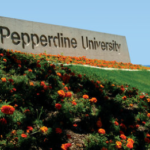How to Get Into Stanford in 2025: Stats + Tips
What’s Covered:
- How Hard Is It to Get Into Stanford University?
- Average Academic Profile of Accepted Stanford University Students
- What Is Stanford University Looking For?
- How to Improve Your Chances of Getting Into Stanford University
- How to Apply to Stanford University
Stanford University is renowned as one of the nation’s top institutions—and one of the most competitive colleges to gain admission to. Many factors draw college-bound high schoolers to Stanford, including its world-class education, gorgeous campus, and athletic excellence—not to mention numerous illustrious alumni, including tech entrepreneurs, Supreme Court Justices, famous actors, notable authors, astronauts, inventors, and even a U.S. President.
If you’re hoping to gain acceptance to Stanford, here’s everything you need to know to improve your chances.
How Hard Is It to Get Into Stanford University?
During the 2024–2025 admissions cycle, 57,326 students applied to Stanford, and only 2,067 were admitted—an acceptance rate of just 4%.
It’s no surprise Stanford is often called the “Ivy of the West.” CollegeVine ranks it among the top non-Ivy institutions, and national polls frequently place Stanford above many elite East Coast universities. Like its Ivy League peers, Stanford is exceptionally selective and draws some of the most accomplished applicants in the country.
To get a clearer picture of your chances at Stanford, try our free chancing calculator. It evaluates your grades, test scores, and extracurriculars to estimate your likelihood of admission—and offers personalized tips to strengthen your college profile.
Average Academic Profile of Accepted Stanford University Students
GPA
The average high school GPA for students admitted to Stanford in the 2024–2025 cycle was 3.94. An impressive 73.3% of admitted students earned a 4.0 GPA.
SAT/ACT
The middle 50% of students admitted to Stanford during the 2024-2025 admissions cycle scored between 1510 and 1570 on the SAT, and the middle 50% had a composite ACT score between 34 and 35.
Of students applying to Stanford during the 2024-2025 admissions cycle, 50.3% submitted an SAT score, and 19% submitted an ACT score. Stanford has been test-optional since 2020, but will resume testing requirements in the 2025-2026 admissions cycle.
Class Rank
Stanford considers class rank “very important” to admissions decisions. A remarkable 97.8% of the students accepted during the 2024-2025 admissions cycle graduated in the top 10% of their high school class.
What Is Stanford University Looking For?
At a highly selective school with a low acceptance rate, such as Stanford, exceptional academics are not enough to gain admission—nearly every applicant has superb grades and outstanding test scores. Knowing what Stanford is looking for in an applicant is one way to gain an advantage over others seeking admission.
Stanford strikes a balance between colleges like MIT and Harvard; it values applicants with technical experience and those who have demonstrated leadership in a variety of areas. One way that Stanford differentiates itself from the schools of the Ivy League—except, perhaps, Princeton—is the priority it places on STEM over fields like business and the humanities.
Stanford considers essays to be a “very important” criterion when making admissions decisions. The university places a relatively high weight on them compared to its peers. Stanford applicants are required to write three short supplemental essays—between 100 and 250 words each—as part of their application. These essays provide an excellent opportunity for applicants to show why they belong at Stanford; however, if not written well, they’re likely to hinder their chances of acceptance.
How Stanford University Evaluates Applications
According to their 2024-2025 Common Data Set, Stanford University considers the following factors “very important”:
- Course rigor
- Class rank
- GPA
- Essay
- Recommendation letters
These other factors are “considered”:
- Standardized test scores
- Interview
- First-generation student
- Alumni/ae relation
- Geographic residence
- Volunteer work
- Work experience
And these are “not considered”:
- State residence
- Religious affiliation
- Level of interest
How to Improve Your Chances of Getting Into Stanford University
1. Achieve at least a 3.94 GPA while taking the most challenging classes available
Stanford considers GPA, class rank, and the rigor of coursework “very important” when making admissions decisions. Consequently, it’s critical that Stanford applicants not only possess outstanding grades, but to also earn those grades in challenging courses. How many AP classes should you take? Students accepted to a top ten school like Stanford typically complete between 8 and 12, but it’s not uncommon for a student to have taken even more.
Another reason Stanford applicants need great grades is that selective schools use a tool called the Academic Index to screen their enormous number of applicants. In its most basic form, the Academic Index is a distillation of a student’s academic performance (grades and test scores) into a single numerical value. Colleges use that number to filter out students deemed academically unqualified.
If your GPA is on the lower side and you’re early in your high school career, there’s still time to improve your GPA. If you’re a junior or senior, it will be harder to improve your GPA, so the easiest way to boost your Academic Index is to get a higher test score.
2. Aim for a 1570 on the SAT or a 35 on the ACT
The middle 50% of students admitted to Stanford in the 2024-2025 admission cycle got between 1510 and 1570 on the SAT. The middle 50% ACT score was between 34 and 35. Any score in the middle 50% is good, but the closer an applicant’s score is to the 75th percentile (the upper bound of the middle 50%), the better their odds of admission will be.
As noted above, Stanford has been test-optional in recent years, but it will resume requiring standardized test scores for the 2025–2026 admissions cycle.
To improve your SAT/ACT score, check out these free CollegeVine resources:
- How to Get a Perfect 1600 Score on the SAT
- How to Get a Perfect 36 Score on the ACT
- More SAT Info and Tips
- More ACT Info and Tips
3. Cultivate at least one or two Tier 1-2 extracurriculars (find your “spike”)
Extracurricular activities are a common way for applicants to separate themselves from the field, but not all extracurriculars are created equal. Stanford considers talent/ability “very important” when making admissions decisions, and extracurricular activities are an excellent way to demonstrate these qualities. An easy way to understand their impact is through the Four Tiers of Extracurriculars:
- Tier 1 activities are the most eye-catching; they demonstrate exceptional achievement and are extremely rare. Tier 1 extracurriculars include impressive accomplishments like winning the Regeneron Science Talent Search or the Jack Kent Cooke Young Artist Award.
-
Tier 2 extracurriculars demonstrate high levels of achievement or leadership but are more common than Tier 1 activities. Tier 2 activities include everything from making an all-state selection in athletics or band to holding a top leadership position in a well-known club, like Model UN or Science Olympiad.
-
Tier 3 extracurricular activities are great for demonstrating an applicant’s interests outside of the classroom, but don’t have the cachet of higher-tiered extracurriculars. Tier 3 activities include holding a lesser leadership position in a club, like treasurer. Similarly, athletes who didn’t make an all-state team but earned recognition, such as a student who wins a player of the week award, fall into Tier 3.
- Tier 4 extracurriculars are the least impressive and most common of the four tiers. These activities include everything from participation in a club (without holding a leadership position) to volunteering to playing a sport or instrument without distinction.
Competitive applicants at a top school like Stanford generally have one or two Tier 1 or Tier 2 activities on their resumes. The belief that colleges are looking for well-rounded students is a myth—applicants are more appealing if they have a highly developed interest known as a “spike,” rather than a bunch of unrelated interests.
4. Write engaging essays
Stanford’s application requires four essays—the personal essay found in the Common Application and three short-answer questions in the Stanford Supplement:
-
The Stanford community is deeply curious and driven to learn in and out of the classroom. Reflect on an idea or experience that makes you genuinely excited about learning.
-
Virtually all of Stanford’s undergraduates live on campus. Write a note to your future roommate that reveals something about you or that will help your roommate—and us—get to know you better.
- Please describe what aspects of your life experiences, interests and character would help you make a distinctive contribution as an undergraduate to Stanford University.
Stanford values essays and considers character/personal qualities “very important” when considering applicants. The result is that essays are often a make-or-break area for applicants, which provides them with the chance to set themselves apart from the competition and show why they belong on Stanford’s campus.
For great advice on how to write a compelling Stanford essay, check out our article How to Write the Stanford University Essays 2025-2026.
5. Apply Early Action
Stanford offers a restrictive early action application—a non-binding option that prevents applicants from applying to any other private college/university under their early action, restrictive early action, early decision, or early notification plans.
While Stanford doesn’t release its early admissions data, the acceptance rates for early applications tend to be higher than those for regular decision, even while controlling for profile strength.
6. Recommendation Letters
Stanford considers letters of recommendation a “very important” factor in making admissions decisions, and requires three of them—one from a high school counselor and two from teachers. Stanford suggests that you seek recommendations from teachers who taught you in 11th or 12th grade in a core academic field like English, math, science, world language, or history/social studies; however, applicants may submit a letter of recommendation from a 10th-grade teacher if the coursework was advanced, such as AP or IB.
Stanford also allows applicants to submit one optional letter of recommendation. This option is best used if there is a person who knows the applicant well and can offer valuable insights that their high school counselor or teachers might not shine a light on.
Requesting a letter of recommendation from a teacher is a big ask—they’re busy and don’t get paid to write recommendations. Make it easy for them by giving them plenty of time, providing them with as much relevant information as possible, and following the other nine rules of requesting letters of recommendation from teachers.
How to Apply to Stanford University
|
Application Timeline |
Deadline |
Notification Date |
|
Restrictive Early Action |
November 1 |
January 5 |
|
Regular Decision |
Mid-December |
Early April |
Application Requirements
Stanford applicants can apply using either the Common Application. The other Stanford application requirements are:
- SAT/ACT scores (beginning in 2025-2026)
- School Report and counselor letter of recommendation
- Official transcript
- Midyear transcript
- Teacher letters of recommendation (2)
Other optional materials include:
- Optional arts portfolio
Learn More About Stanford University
-
Interested in learning more about Stanford? Check out these other informative articles:



